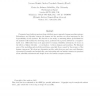Free Online Productivity Tools
i2Speak
i2Symbol
i2OCR
iTex2Img
iWeb2Print
iWeb2Shot
i2Type
iPdf2Split
iPdf2Merge
i2Bopomofo
i2Arabic
i2Style
i2Image
i2PDF
iLatex2Rtf
Sci2ools
DSN
2003
IEEE
2003
IEEE
Human-Machine Diversity in the Use of Computerised Advisory Systems: A Case Study
Computer-based advisory systems form with their users composite, human-machine systems. Redundancy and diversity between the human and the machine are often important for the dependability of such systems. We describe a case study on assessing failure probabilities for the analysis of X-ray films for detecting cancer, performed by a person assisted by a computerbased tool. Differently from most approaches to human reliability assessment, we focus on the effects of failure diversity – or correlation – between humans and machines. We illustrate some of the modelling and prediction problems, especially those caused by the presence of the human component. We show two alternative models, with their pros and cons, and illustrate, via numerical examples and analytically, some interesting and non-intuitive answers to questions about reliability assessment and design choices for human-computer systems. Copyright of the authors, 2002 This work has been submitted to the IEEE for possible ...
Computer Networks | Computer-based Advisory Systems | DSN 2003 | Human Reliability Assessment | Reliability Assessment |
| Added | 04 Jul 2010 |
| Updated | 04 Jul 2010 |
| Type | Conference |
| Year | 2003 |
| Where | DSN |
| Authors | Lorenzo Strigini, Andrey Povyakalo, Eugenio Alberdi |
Comments (0)

